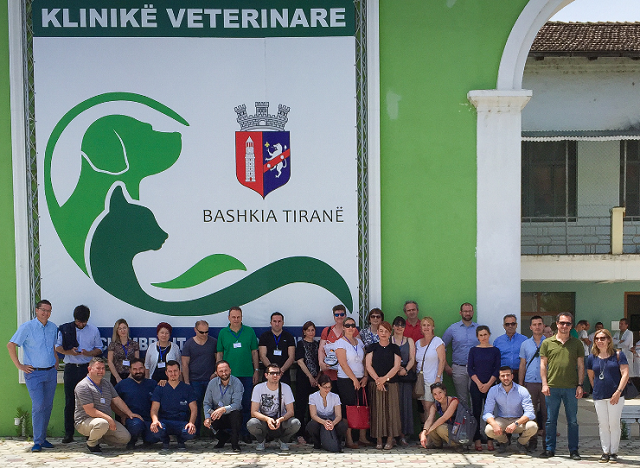
Second OIE Regional Workshop on Stray Dog population management for Balkan countries (SDB2)

The Second OIE Regional Workshop on stray dog population management for Balkan countries (SDB2) took place from 14 to 16 June 2016 in Tirana (Albania).
This workshop is an integral activity of the Regional stray dog Roadmap on stray for Balkan Countries, launched in June 2014 with the objective to become compliant with OIE Chapter 7.7 of Terrestrial Animal Health Code by 2025.
Workshop objectives
The overall objective of the SDB2 workshop was to support countries to comply with the OIE intergovernmental standards on stray dog population control (Chapter 7.7) and rabies (Chapter 8.11). Given its pertinence for the region and in the context of the recently adopted Global Framework for the elimination of dog-mediated rabies, the Workshop included an increased focus on the control of dog-mediated rabies compared to the SDB1.
More specifically, the objectives of the SDB2 workshop were to:
- Discuss national and regional situation with regards to stray dog population control and measure progress since 2014 towards the agreed Vision;
- Identify the key weaknesses/constraints/challenges as well as opportunities in the implementation of the OIE standards (if any);
- Share best practices of sustainable management of stray dogs in the region;
- Support the definition of national and regional stray dog roadmaps 2016 – 2018.
Workshop presentations:
Session 1 — Setting the scene session
OIE new developments on Animal Welfare (OIE)
OIE Platform for Animal Welfare in Europe – New development since 2014 (OIE and IZSAM Teramo)
Stray dog as a societal issue (IZSAM Teramo)
Session 2 — Country reports
Albania
Bosnia and Herzegovina
Bulgaria
Croatia
Former Yugoslav Republic of Macedonia
Greece
Kosovo
Montenegro
Romania
Serbia
Turkey
Session 4—Addressing the Challenges
Topic 1 — Finalizing the Assessment Phase – How to conduct a stray dog survey
Surveying roaming dog populations (World Animal Protection)
How to conduct a stray dog survey - Country experience (FYR Macedonia)
Topic 2 — Legal/illegal trade of dogs
Dog Trade in Europe (FVE/FECAVA)
Topic 3 — National framework on stray dog population control
How to design a Framework that incorporates all actors? (IZSAM Teramo)
Topic 4 – Identification and registration of dogs
Key requirements for a secure and compatible system of identification and registration of dogs in Europe (VIER PFOTEN)
The national dog registration database - Country experience (Croatia)
Session 5—Designing a three-year Roadmap
Elements of a comprehensive Stray Dog population control Strategy (RSPCA)
Evidence-based dog population control at the local level: an example of good practice from Serbia (ORCA)
Session 6 — Closing session
Next steps
As the next steps countries are expected:
- To build their National Stray Dog Roadmap 2016-2018 using the pathway proposed in their National Stray Dog Report (stemming from the results of their 2015 self-assessment). Countries are expected to provide the Platform Secretariat with concrete proposals before the end of 2016 and to indicate what kind of external support is needed to implement their roadmap (if needed);
- To include in the National Stray Dog Roadmap specific activities on the control/elimination of dog-mediated rabies, in line with the Global Framework for the elimination of dog-mediated rabies adopted in Geneva in December 2015.
- To consider establishing a National Advisory Group on stray dog population control (or national framework for dog population management), to best support the implementation of the national stray dog Roadmaps. This Advisory Group is recommended in article 7.7.5 of the OIE TAHC.
- To consider conducting a second self-assessment before the SDB3 using the SAM tool in order to have an understanding of their progress over time (and remaining gaps).
